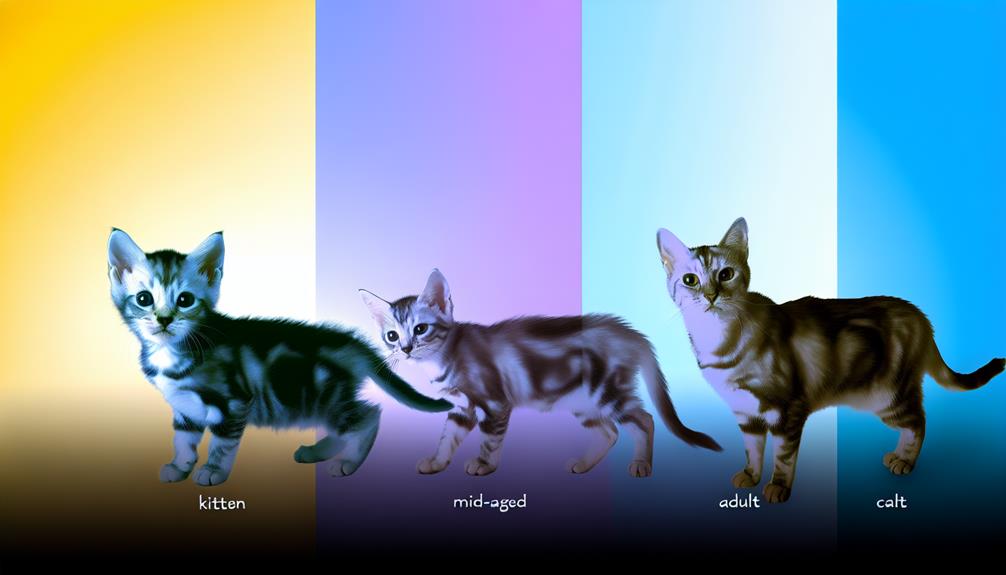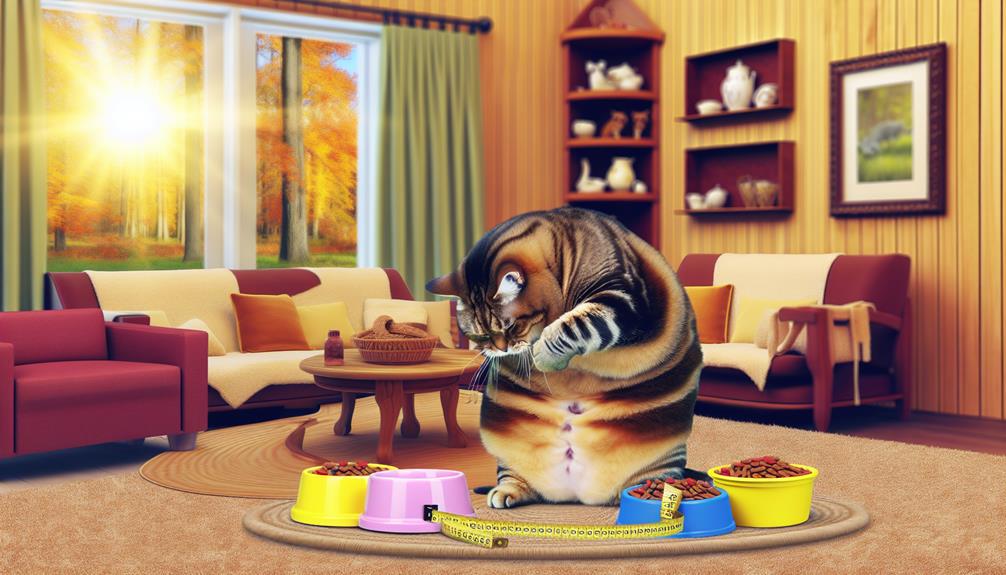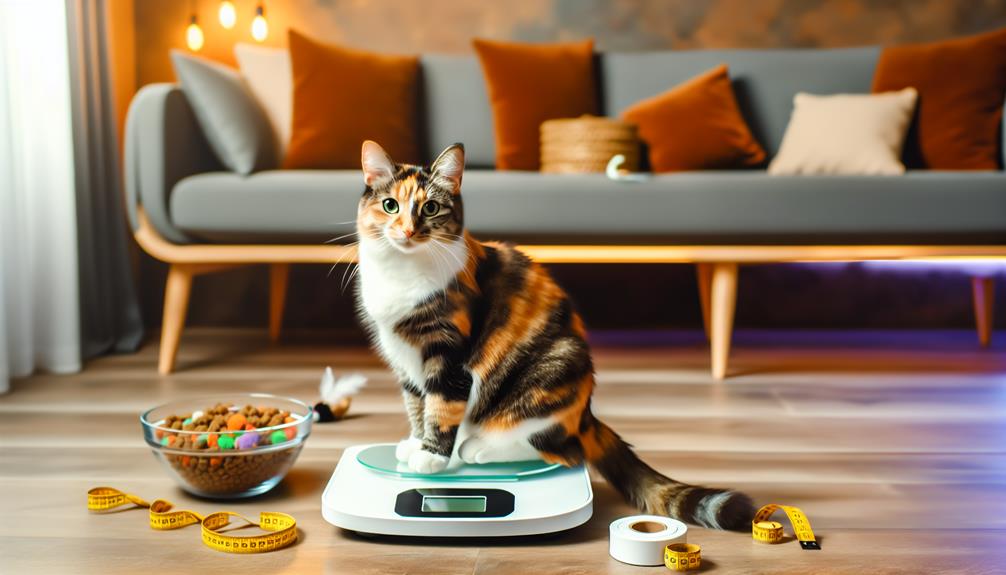When considering how much a cat should weigh, it's vital to recognize that there's no one-size-fits-all answer. Factors like breed, age, and activity level all play significant roles in determining an ideal weight. For instance, while a Maine Coon may tip the scales at 25 pounds, a Siamese cat might be perfectly healthy at just 6 pounds. But how do you know if your cat's weight is just right? Understanding the signs of unhealthy weight and the steps you can take to guarantee your feline friend stays fit is important. Let's explore these aspects further.
Factors Affecting Cat Weight
When determining the ideal weight for a cat, several factors come into play, each influencing the cat's health and well-being. One of the primary factors is the cat's metabolic rate. A cat's metabolism dictates how efficiently it converts food into energy and can vary considerably among individuals. Cats with a higher metabolic rate will naturally burn more calories and may require a higher caloric intake to maintain an optimal weight. Conversely, cats with a lower metabolic rate might gain weight more easily and could benefit from a carefully monitored diet to prevent obesity.
Dietary habits are another critical factor affecting a cat's weight. What and how much your cat eats plays a vital role in its overall health. Free-feeding, or allowing your cat to graze on food throughout the day, can lead to overeating and subsequent weight gain. Structured feeding schedules and portion control are effective strategies to guarantee your cat receives the appropriate amount of nutrients without excess calories. Additionally, the quality of the diet is paramount. High-protein, low-carbohydrate diets can help sustain lean muscle mass and prevent fat accumulation.
Moreover, it is crucial to take into account the cat's age and activity level. Kittens and young cats often have higher energy levels and metabolic rates, necessitating more frequent feeding. In contrast, older cats may have decreased activity levels and slower metabolisms, requiring fewer calories to maintain a healthy weight.
Ideal Weight by Breed
When determining your cat's ideal weight, it's essential to take into account breed-specific weight ranges, as these can vary considerably. Certain breeds are predisposed to common weight issues, such as obesity in British Shorthairs or underweight tendencies in Siamese cats. Understanding these breed-specific tendencies will help you maintain your cat's best health.
Breed-Specific Weight Ranges
Different cat breeds can exhibit significant variation in their ideal weight ranges due to their unique genetic profiles and physical characteristics. Understanding these breed characteristics is vital for determining the appropriate weight standards. For instance, a Maine Coon, known for its robust structure, will naturally have a higher weight range compared to a more petite breed like the Siamese.
Here are some examples of breed-specific weight ranges:
- Maine Coon: Typically, this breed ranges from 10 to 25 pounds due to its large bone structure and muscular build.
- Siamese: On the other end of the spectrum, Siamese cats generally weigh between 6 to 12 pounds, reflecting their slender physique.
- Persian: Known for their stocky build, Persians usually weigh between 7 to 12 pounds.
- Ragdoll: These large, relaxed cats range from 10 to 20 pounds, correlating with their substantial frame.
- Bengal: With their athletic and muscular build, Bengals typically weigh between 8 to 15 pounds.
Adhering to these weight standards is fundamental for maintaining your cat's health and well-being. Regularly monitoring your cat's weight and consulting with your veterinarian can help ascertain that your feline remains within its ideal weight range based on its breed characteristics.
Common Weight Issues
Many common weight issues in cats stem from deviations from their ideal weight ranges, which can vary considerably by breed. For instance, a Maine Coon's healthy weight differs vastly from that of a Siamese. Deviations from these specific ranges can lead to significant health complications. Overweight cats are at an increased risk for weight related diseases, such as diabetes mellitus, hepatic lipidosis, and arthritis. Conversely, underweight cats may suffer from malnutrition, weakened immune systems, and muscle wasting.
Dietary influences play an important role in maintaining your cat's ideal weight. Overfeeding, providing calorie-dense food, and excessive treats can cause obesity, while inadequate nutrition can lead to underweight conditions. It is vital to consult with a veterinarian to determine the appropriate diet and portion sizes tailored to your cat's breed, age, and activity level. Regular monitoring of your cat's weight and body condition score can help you detect and address deviations early.
Age and Weight Correlation

A cat's weight is considerably influenced by its age, with distinct stages marking different weight norms and expectations. From the rapid kitten growth phase to the more gradual weight changes seen in senior cats, understanding these stages can help you guarantee your feline friend maintains a healthy weight throughout its life.
Kitten Growth (0-1 year): This stage is characterized by rapid development and weight gain. Kittens typically double their birth weight within the first week and continue to grow quickly, reaching approximately 75% of their adult weight by six months.
- Neonatal Period (0-2 weeks): Kittens should gain about 10-15 grams per day.
- Weaning Phase (4-8 weeks): Expect significant weight increases as kittens shift from milk to solid food.
- Juvenile Stage (2-6 months): A steady growth rate, with weights varying based on breed and genetics.
Adult Stage (1-7 years): Once a cat reaches adulthood, its weight should stabilize. Adult cats generally weigh between 9-12 pounds, although this can vary by breed and individual factors.
Senior Weight (7+ years): As cats age, their metabolism slows down, and they may experience muscle loss. Monitoring senior weight is essential to prevent obesity or undesirable weight loss, both of which can be signs of underlying health issues.
- Early Senior (7-10 years): A moderate weight gain or loss may occur.
- Geriatric Phase (10+ years): A more pronounced weight change, often requiring dietary adjustments and regular vet check-ups.
Activity Level Considerations
While age plays a notable role in determining a cat's weight, activity level is another critical factor that shouldn't be overlooked. A cat's daily energy expenditure greatly influences its ideal weight. Cats with high activity levels typically require more calories and may have a leaner physique compared to sedentary cats. Understanding your cat's activity level can guide you in making appropriate exercise routines and dietary adjustments.
To illustrate this, consider the following table which categorizes activity levels and their corresponding dietary recommendations:
| Activity Level | Exercise Routines | Dietary Adjustments |
|---|---|---|
| Low | Minimal play; indoor only | Lower caloric intake, high-fiber diet |
| Moderate | Regular play; occasional walks | Balanced diet, moderate portion sizes |
| High | Active play; outdoor access | Higher caloric intake, nutrient-rich |
| Very High | Intense play; agility training | High-protein diet, frequent feeding |
| Special Needs | Limited mobility; medical care | Customized diet, consult veterinarian |
Low activity cats, often indoor and less stimulated, benefit from a low-calorie, high-fiber diet to prevent weight gain. Moderate activity cats, which engage in regular play and occasional walks, require a balanced diet with moderate portion sizes. High activity cats, who enjoy active play and outdoor access, need a higher caloric intake to support their energy expenditure. For cats with very high activity levels, such as those involved in agility training, a high-protein diet and more frequent feeding can be beneficial. Cats with special needs, including those with limited mobility, should have their diets customized in consultation with a veterinarian to guarantee they receive appropriate nutrition.
Signs of Overweight Cats

Recognizing the signs of overweight cats is essential for maintaining their overall health and well-being. An overweight cat is at increased risk for various health complications such as diabetes, arthritis, and cardiovascular issues. Understanding the indicators of excess weight can help you take proactive steps in weight management and guarantee your feline companion maintains an ideal body condition.
Here are some clinical signs to watch for:
- Difficulty in feeling ribs: When you gently palpate your cat's ribs, they should be easily felt without a significant layer of fat covering them. If you struggle to feel the ribs, this might indicate excess fat.
- Visible waist absence: From a top-down view, an ideal body condition should show a noticeable waist behind the ribs. If this waistline is not apparent, your cat may be overweight.
- Excess abdominal fat: Check for a pronounced abdomen or a "sagging" belly. An accumulation of fat in this area is a common sign of overweight cats.
- Limited mobility: Observe if your cat shows reluctance or difficulty in jumping, climbing, or engaging in physical activities. Reduced mobility can be a consequence of carrying extra weight.
- Behavioral changes: Overweight cats may exhibit lethargy, decreased interest in play, or changes in grooming habits, often due to the physical burden of extra weight.
Monitoring and Maintaining Weight
Evaluating your cat for signs of being overweight is just the first step; maintaining a healthy weight requires ongoing vigilance and care. Effective weight management involves regular monitoring and adherence to specific feeding guidelines. Start by weighing your cat every two weeks using a reliable digital scale. Document these weights to identify any trends and consult your veterinarian for tailored advice.
Feeding guidelines play a critical role in weight management. It's crucial to follow the recommended daily caloric intake based on your cat's ideal weight, age, and activity level. Opt for high-quality, balanced diets formulated for weight control. Avoid free-feeding; instead, implement portion-controlled meals. Divide the daily food allowance into two or more meals to prevent overeating and promote satiety.
Regular physical activity is another cornerstone of effective weight management. Engage your cat in daily play sessions using interactive toys like feather wands or laser pointers. Encourage activities that mimic natural hunting behaviors, which can help burn calories and maintain muscle mass. Additionally, consider environmental enrichment strategies such as puzzle feeders to stimulate both physical and mental activity.
Routine veterinary check-ups are indispensable for monitoring your cat's overall health and weight. These visits allow for the early detection of any weight-related issues, enabling timely interventions. Your veterinarian may suggest supplementary strategies like prescription diets or specific therapeutic exercises tailored to your cat's needs.
Conclusion
Just like a finely tuned instrument, your cat's weight needs careful calibration. Think of it as maintaining a delicate balance in a symphony. When each element—breed, age, activity level—is in harmony, your feline friend thrives. Regular monitoring guarantees you catch any discord early, preventing health issues. By understanding and addressing these factors, you're the conductor of your cat's well-being, orchestrating a life of health and liveliness. Keep the symphony playing smoothly by staying vigilant and informed.
